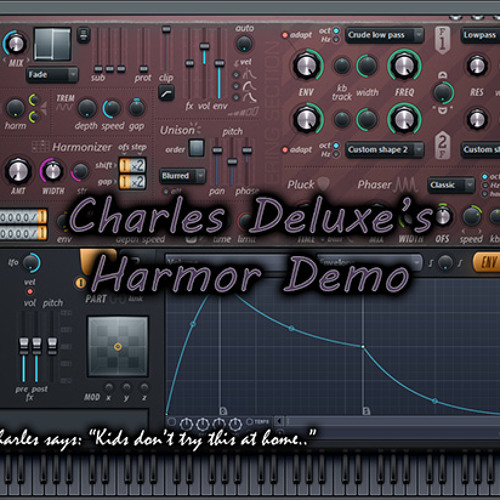How To Use Harmor
Here’s an audio example (dressed with drum loop):Ok. To create something like that, first, open Harmor. You may also want to draw some note to the Harmor’s Piano Roll for a quick preview and audition purposes.Alright! Creating sequences in Harmor is very easy: it’s all about drawing a rhythmical and (preferably) tempo synced modulations targeting one or more of the many Harmor’s parameters using the envelope editor window. First, you need to select the TARGET parameter you want to modulate. Next, define HOW you want to modulate it by choosing the articulator (Envelope or LFO).The envelope is a good choice as the editor lets you freely draw all kinds of curves and shapes and allows you to have precise control how the modulation should behave. In this tutorial example, I’m modulating the pitch with the envelope as an articulator.
- How To Use Harbor Freight Mini Tire Changer
- How To Use Harmor Fl Studio
- How To Use Harmor In Fl Studio
So all I have to do is I select the pitch as a target:Next, I enable the envelope and switch on the tempo-based time to sync the envelope to tempo. Also, the SNAP is handy to keep ON if you want to snap your curve editing to the editor grid. It’s particularly handy when editing pitch envelope as it lets you move and draw in 100 cent steps (100 cents is one semitone and one octave is twelve semitones = 1200 cents). This way it’s easier to create melodic sequences that are in tune.Ok.
Now I add a new envelope point to the grid. I’m also going to loop it (the length of my sequence is going to be only two beats – that’s half a bar). To loop the sequence, define loop start and end points.
In this example, loop start point is going to be the envelope point 1. To set the loop points, right click an envelope point to open a menu and select ‘Loop start’. To set the loop end point, right click another envelope point and select ‘Sustain / loop end’ from the menu. And now, I’ll just start to draw the sequence. I don’t have anything specific in mind so I’ll just randomly create a different kind of curvesNext, I’ll draw a modulation sequence for the Filter 1 cutoff frequency.First, I’ll set the editor target as Filter 1 frequency and again, I’ll switch on the envelope and sync it with the tempo. I’m going to draw some rhythmic sequence that is the same length as the pitch sequence.
I’m also going to loop it so I’ll set the loop start and end points the same way as I did with the pitch envelope. And again, I’ll just draw something random.Basically, that’s it!There are lots of different parameters you can use for creating sequences in Harmor. For example, try modulating Filter Resonance Amount and Prism Amount alongside with the Pitch and Filter Frequency.The more parameters you modulate and the longer you make your sequences, the more complex stuff you are able to come up with.Remember, that you can also use different curves in the envelope editor window: just right click any envelope point to open a menu and choose a different curve. Such as ‘Hold’.You can also use the ‘Envelope sequencer’ which you can find under the ‘Options’ menu:But that’s not all.

To further develop your sequences, add some effects. I’ll show you what kind of effects I used in the audio example you heard at the beginning of this video.In the FX section of Harmor, I used Ribbon distortion. There’s no particular reason why I picked the Ribbon. It just sounded ok to my ears. The distortion low pass (or high cut) filter value I set to maximum because to my taste the distortion didn’t require any cuts in the higher frequency area. The distortion amount I set to fairly high. Again, based on my taste.I also used a bit of Harmor’s compression.
How To Use Harbor Freight Mini Tire Changer
The compression unit in Harmor is based on Maximus engine and the way it has been set up (think of Soundgoodizer) adds a nice ‘final touch’ to most of the sounds you are creating with Harmor.I also used Reverb. I wanted to add that ‘roomy’ ambiance as a special effect so I used a short decay time. The reverb wet level I set to fairly high.
How To Use Harmor Fl Studio
And once again, based on my taste.In the filter section of Harmor, I also increased the Filter 1 Resonance level to make the sound scream and creak a bit.I also utilized the Prism. Prism is a special processing unit that affects to the harmonics of a sound. When used only a little it kind of detunes the sound. It adds a cool flavor to a distorted saw wave so I used it.I also used Harmonizer. Harmonizer clones and transposes the existing harmonics. In this example, I set the Harmonizer mix level to maximum to make the sound kind of scream even more.Next, back to the Filter section again.Few words about the Filter Envelope Amount: filter envelope amount controls the filter envelope modulation amount – i.e how intense you want the modulation to be.
How To Use Harmor In Fl Studio
In Harmor, it’s bi-directional meaning you can use negative values as well. So, to quickly add variation to the filter envelope (sequence) turn it all the way to left (negative) and it kind of turns your current envelope upside down.Okay. What I did next I created automation clips for the Filter 1 frequency and Filter 1 envelope amount knobs and edited the automation curves like shown below:The end!Watch the video version below:(.fst file).